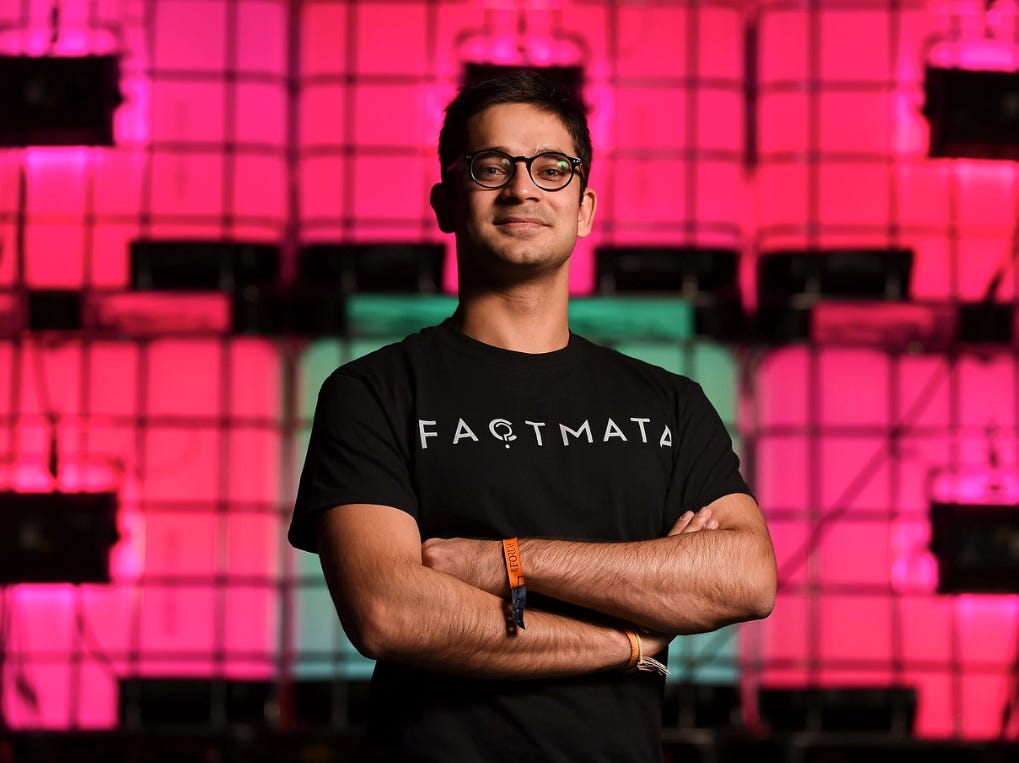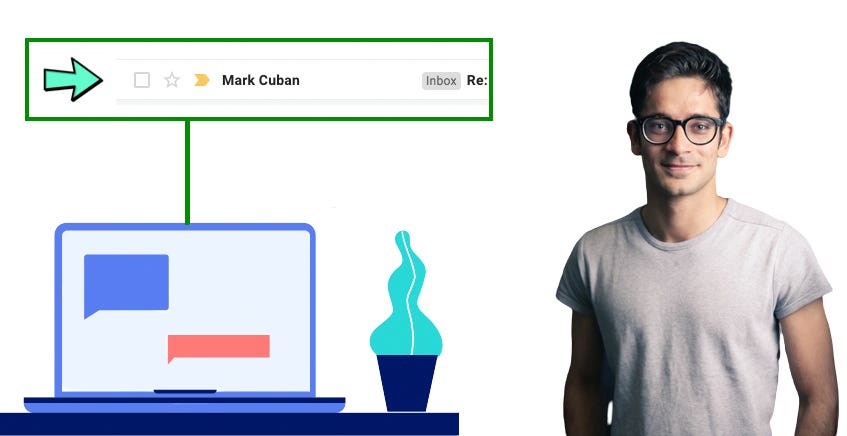How A First-Time Founder Raised $1m By Cold Email (And Zero Intros)
From Mark Cuban and the founders of Twitter, Zynga, and Craigslist.
Hello 👋
Martin here. Welcome to another edition of Founders’ Hustle!
I write about the “hustle” of entrepreneurship and startup building frameworks.
Today I’m sharing how first-time founder Dhruv Ghulati raised a seed round for his pre-product startup by cold emailing world-famous entrepreneurs and investors!
Dhruv closed $1m from Mark Cuban and the elite of Silicon Valley. 🔥
No intros or network. His emails were cold! 📧
Plus, he’s shared the email copy he used to close investment 😮
Not subscribed? Let’s fix that now 😉👇
Cold emailing has been one of the most popular topics I’ve written about through Founders’ Hustle so far.
The idea that you can connect with someone extremely knowledgable, well-connected, or wealthy — from anywhere in the world, right now, for free — is incredibly compelling.
It’s such a powerful mechanism, partly because the returns can be so massively asymmetrical. 📈
The act of sending a cold email in itself is a small investment, but, if structured well, can deliver life-changing results.
Things like landing investment, your first client, a key hire, or incredible advice.
I’m not just saying this. It’s been a critical lever for me as a founder.
I launched and built two successful B2B startups from scratch almost entirely through cold emailing.
And, the results were fast and real. 👊
The last one grew from nothing to a $4m run rate in its first year.
For new founders—who may have no network to tap into—cold emailing is a crucial skillset to utilize, hone, and execute.
This is the exact position I found myself in a decade ago and leveraged to my advantage.
To empower others, I shared one of my cold outreach frameworks in a Founders’ Hustle post—How I Write Cold Emails to Billionaires That Get Replies.
It clearly resonated. With over 6,000 views, it’s my most viewed post.
Since then, I’ve received a ton of awesome followup from folks who’ve utilized my framework and achieved success. 👇
I also received similar feedback on a very specific follow-up post—How to Pitch Mark Cuban via Cold Email.
It’s great to hear founders benefitting directly from my writing.
So, my intention is to cover the science and best practices of cold emailing more going forward.
And, starting today, I’m going to loop in other founders who’ve achieved incredible outcomes through cold emailing that are insightfully different, better in their end result, or just damn cooler than my own endeavors. 😎
So, let me introduce you to our first guest case study on this subject—Dhruv Ghulati, CEO of Factmata. 👇

Factmata is an AI startup that’s raised $3.5m over the last four years to fight online misinformation.
I got talking to Dhruv as part of my research for the Mark Cuban story—yes, via cold email!
As a first-time founder, he has achieved some astonishing results from cold outreach that will simply make your draw drop. 😮
This includes raising a $1m seed round from some of the biggest names in tech and investing:
🏀 Mark Cuban (billionaire Dallas Mavericks owner)
🐦 Biz Stone (co-founder, Twitter)
🕹️ Mark Pincus (founder, Zynga)
🏷️ Craig Newmark (founder, Craigslist)
But, it doesn't stop there.
Cold outreach has been a big part of his overall journey as a founder, to the degree he’s built an entire mental model around it. 🧠
His thinking goes pretty deep on this—with intentions to write a book one day.
One of the empowering takeaways from Dhruv’s experience is the fact it’s diametrically opposed to the commonly held perception that ‘warm intros’ are needed to close a funding round.
I was fortunate to jump on a video call with him, and below I share highlights from our conversation.
It’s both highly inspirational and actionable. 👇
Quick Bio + Context
First, let me introduce you to who Dhruv Ghulati is a little bit.
Before founding Factmata, he had some incredible experiences working at Bank of America Merrill Lynch, two early stage venture-backed AI startups, and as a participant in both TechStars and Entrepreneur First.
Amongst all of that, he found time to take a Masters in Computer Science at University College London, where he achieved a Distinction and won the Dean's List Award for finishing 2nd out of 64 students who took the course.
So, it’s fair to say here’s a pretty smart dude. 🤓
But, just focusing on credentials would be an injustice.
It’s clear Dhruv possesses a true entrepreneurial mindset.
Factmata is not just an altruistic academic experiment. He’s on a mission to build a venture-scale business and is not afraid to roll up his sleeves and embrace that head on with admirable conviction and tenacity.
Let me give you an example.
After leaving Entrepreneur First to launch Factmata, Dhruv took out a £25,000 loan (about $33,000 in 2017) to finance the first few months so he could throw himself fully into it.
That’s a pretty bold and hair-raising move. 😬
But, that money would quickly run out. So, he decided to go about raising a seed round.
There was no product, business model, or customer base to speak of. Investors would have to be sold on the narrative, vision, and his ability to execute.
That’s a pretty tough scenario to pull off. Particularly for first-time founders with no prior exit or ‘decacorn’ logos on their resume.
Fortunately, both Factmata and Dhruv were a potent combination—and the timing was spot on.
Let’s put events into context. 🧐
Factmata’s founding mission was to fight online misinformation and Dhruv had the vision and technical credentials to propose a credible approach for tackling it profitably.
This was perfect because ‘fake news’ was a red hot topic when the fundraising process started—shortly after Donald Trump had been elected President.
Emotions amongst the wealthy and tech elite were raw and palpable. 🤬
This was a perfect ‘hook’ to draw the attention of angel investors, so it became the basis for his cold outreach campaign.
Dhruv strategically approached wealthy individuals who had been publically vocal about Trump—or fake news in general—and utilized this as a mechanism to start a meaningful conversation.
Many conversations were established with high-profile figures in business, tech, and entertainment, not just those that invested. Fake news was clearly a provocative subject that drew attention. 🎣
"Every single investor we have has some element of being extremely strategic and important for the business. It was about making that clear to the investor, as opposed to just, 'Why am I randomly emailing you?'" he previously told Business Insider.
This included Mark Cuban, who had been very publicly vocal about Trump and ‘fake news’ issues in general around the time of the 2016 election.
We’ll use the Shark Tank billionaire as a case study for Dhruv’s cold email outreach framework next. 👇
Pitching and Closing Mark Cuban!
Dhruv has been incredibly awesome and shared a lot of detail on both how he approached investor targets, and, how he closed those leads for investment once dialogue was established.
Unlike a lot of other coverage on this topic, he’s pulling back the curtain and showing the exact language he used to establish interest from top angel investors and close funding thereafter.
This is the cold email he sent to Mark Cuban. 👇
Reaching out - Factmata
Dear Mr. Cuban,
Apologies for my cold message. I am the founder of a Google backed startup called Factmata, that uses artificial intelligence to perform automated fact checking and referencing. We are a team of 3 NLP researchers and scientists with 30+ published and cited papers within natural language processing, question answering and information extraction.I am currently fundraising from people who care about the problem of online misinformation, want to reduce mistrust in the media, and change the way we consume online content. I would love to tell you more about us if of interest, especially given your recent public discussions about this topic.
Look forward to hearing from you soon,
Best regards,
Dhruv
There are a few things that really stand out with this email.
First off, the email title.
“Reaching out - Factmata” is honest and simple. Not clickbaity at all.
Secondly, establishing credibility.
The early-on sentence “I am the founder of a Google backed startup” achieves this instantly on a broad level.
You want to keep reading. 👀
For context, Dhruv secured €50,000 from Google’s digital news initiative a few months prior.
The next sentence “We are a team of 3 NLP researchers and scientists with 30+ published and cited papers within natural language processing, question answering and information extraction” builds upon the broad-level credibility with deep domain knowledge.
In the reader’s mind, you now view Dhruv and his team as natural language processing experts.
Great start. ✅
The fourth sentence loops the established credibility into a reason for reaching out—fundraising.
It’s also framed in a psychologically provocative way… “I am currently fundraising from people who care about the problem of online misinformation.”
With such an emotionally charged issue, as a reader, it’s hard not to get drawn in.
By ignoring the email you have to basically internally accept online misinformation is not something you really care about enough to take action.
The last sentence wraps the email up logically with an emphasis on why Mark Cuban is being contacted specifically.
This demonstrates consideration in the fundraising approach and helps position Dhruv as a long-term strategic-thinking founder. ♟️
Relationships with shareholders last a long time, so finding those that have the most powerful conviction or expertise in any given' startup’s mission or domain is super important.
It worked!
After hitting send, boom. 💥
A reply came back.
The Dallas Mavericks owner wanted to know more, so Dhruv sent back a teaser deck accompanied by a three-paragraph summary that covered progress to date and both Factmata’s product and financial roadmaps.
Here’s what the email said, anonymized in places. 👇
Attached is a teaser deck about what we are doing.
Here are key points:Started working full time on this in early Jan based on my thesis in machine learning and my professors published papers. Read more about the initial project here.Will have a private alpha ready next month to fulfil the terms of our Google project.
The core of this product will be a Chrome extension but the power of this is in the underlying algorithms and API underneath.Have been speaking to major publishers like [Big Publisher A], [Big Publisher B], [Big Publisher C] etc. to discuss initial pilots, as well as data providers such as [Company A], [Company B], [Company C], and [Company D].
Had a call with [Big Tech Company] Head of AI research, signing an NDA next week.Raising $500k will give us 13 months of traction, $700k will give us the typical seed traction of 18 months. Process has started.
Happy and excited to jump on a quick call to tell you more.
A few days went by and there was no response. *crickets*
So, Dhruv chased up:
Dear Mark,Hope you are well. Did you have any thoughts on Factmata and my applied AI business for cracking online misinformation?Given your public awareness and views on this topic (which I side with) I would love to have you on board as my investor. Happy to answer any questions you have.Best,Dhruv
Checking in like that ignited the conversation big time. 🔥
Over a few emails, Mark Cuban came back with a flurry of smart questions, suggestions, and observations about the business plan and industry in general.
Since Factmata was pre-product, a lot of the follow-up conversation revolved around possible directions for the business. This was tethered to assumptions over who would be prepared to pay for an anti-misinformation service of some description.
The mission of the company was awesome, but how will it make money?
Questions from the Broadcast.com founder came in fast from multiple angles.
Things like:
💬 Product concerns. R&D versus commercial opportunity.
🎯 Target market concerns. Who wouldn’t buy the solution.
😠 Industry pain points. Problems faced by the media.
💡 Product ideas. Who the solution could help.
📊 Financials. Whose in the round. Runway. Company economics.
Neatly unpacking interrogatory dialogue like this and reformatting it back into a simple and navigable path that stays on track to objectives is both a critical and tricky thing to do.
The conversation can so easily veer off down an unproductive tangent.
Dhruv fielded the questions and presented a framework explaining how Factmata would explore and establish a sustainable and scalable business model.
He also made the effort to show that nothing is set in stone and that he’s open to ideas:
“Open to whatever you think is best strategy.”
Pitching a framework rather than a product is smart because frameworks are more elastic and durable than specific product ideas within the context of an investor pitch.
It’s easy to see flaws and pick apart a specific product idea, but if you credibly layout the framework for which you will go about testing and discovering a viable product, it makes success seem a lot more viable and tangible.
Overall, there’s a couple of themes that stand out from Dhruv’s answers:
🔨 Doer. Showing he takes action and doesn’t sit around waiting for things to happen. For example… part of the Google program, building a private alpha, talking to high profile companies regarding pilots.
🧠 Market knowledge. Demonstrating a credible understanding of market dynamics and what pathways are likely to lead to a chargeable product.
These two elements seem critical since they progress the conversation proposal onward from an interesting academic experiment into a viable business model by a capable CEO.
After Dhruv fired off an email packed full of answers, he got a short reply.
It worked!
Mark Cuban offered to put in $250k. 💪
And, another $250k to follow in six months if things go to plan.
Dhruv got to this point after only six emails!
That works out to potentially $80k+ per email.
Like I said before, asymmetrical returns. 😉
Insights
Dhruv holds a strong view that so much more value could be unlocked in the world if cold outreach was more socially acceptable and normalized—there shouldn’t be artificial obstacles in the way.
That’s not an endorsement of spamming, but, instead, meaningful personalized communication based on a common mutual interest. “You should just be able to reach out” without any constraints. 👋
He thinks a lot of people don’t feel comfortable cold emailing for fear of being awkward or annoying, while on the receiving end many just think it’s a poor signal to receive a cold email or have some ‘warm intro’ belief system that acts as a blocker.
Folks with that mindset miss opportunities and basically act as a limiter of growth.
If these inhibitions and prejudices were broken down more connections would be made that lead to fruitful outcomes. In essence, the global economy would be more productive.
Regardless, there’s still a ton of opportunity with cold outreach.
From Dhruv’s experience, if you have something of value to share and the person you are emailing is generally receptive to cold emails, then you will get a reply.
If they aren’t interested or just aren’t receptive to cold emails, they won’t respond.
It’s no big deal. 🤷
Don’t take it personally and move on to others who are. You just need to find them.
There’s more out there than you think—and don’t let wealth or status put you off.
Dhruv eagerly encourages others to utilize cold outreach to the max because it’s been so critical in his journey founding and building Factmata.
On numerous occasions, Factmata has been close to running out of money.
To the point where runway was down to single-digit weeks. 😬
It could have been the end, but wasn’t.
What saved the company was funds received from investors he’d cold emailed.
This includes the first $250,000 check from Mark Cuban when his personal loan was running out, and, another time an angel wired the company $50,000 days before the business would otherwise become insolvent
Critical events like this “have always happened just in time” he said.
Dhruv says he regularly fires off cold emails. It’s business as usual and not just a mechanism used for fundraising.
A prime example is conferences, where there’s a logical common-ground opportunity to meet new and interesting people.
While maybe 50% of people don’t reply, those that do have been a huge value generator for Factmata. 📈
Actionable Summary
Here’s a quick recap on how to replicate Dhruv’s fundraising cold outreach framework:
⭐ Build ‘sellable credibility’ in the problem you are tackling via education, work experience, and or professional achievements.
🧠 Research your market thoroughly so you can demonstrate a confidence-building level of ability to execute your proposed opportunity.
👊 Take action before reaching out to investors so you can ‘go to the table’ with material progress—prototype, contracts, research.
🎯 Target investors who are heavily emotionally invested in the problem you are tackling. Screen via social media, blogs, news, websites, etc.
✍️ Write a cold email that conveys your credibility overwhelmingly, reason for reaching out, and why you targeted that person specifically.
🔁 Circle back if you don’t hear back, emails get missed!
🗣️ Keep the dialogue focussed on achieving objectives.
💡 Propose frameworks for achieving success, not products.
🤝 Know your deal objectives and company economics in advance so you can negotiate and close effectively.
Until next time!
Martin 👋
To receive more newsletters like this, subscribe below. 👇









This is a brilliant article. Thank you for writing. Regularly sending cold emails has a positive expected value if you do it the right way and do enough of them. Also "credibly layout the framework for which you will go about testing and discovering a viable product" was exactly what I needed to hear. I am changing future emails to start with this framework.